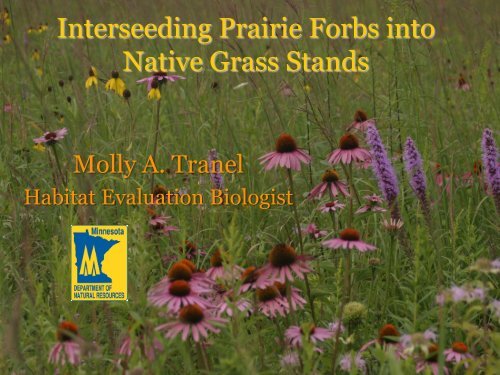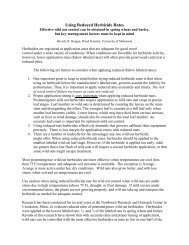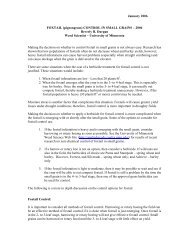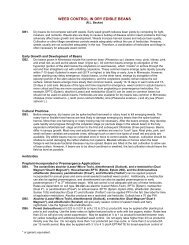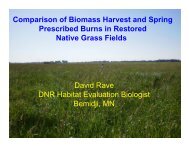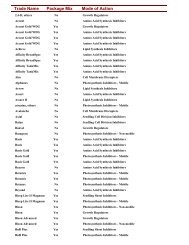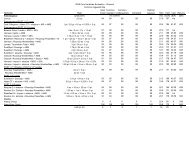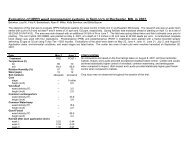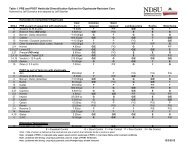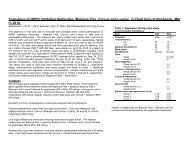Interseeding Prairie Forbs into Native Grass Stands
Interseeding Prairie Forbs into Native Grass Stands
Interseeding Prairie Forbs into Native Grass Stands
You also want an ePaper? Increase the reach of your titles
YUMPU automatically turns print PDFs into web optimized ePapers that Google loves.
<strong>Interseeding</strong> <strong>Prairie</strong> <strong>Forbs</strong> <strong>into</strong><br />
<strong>Native</strong> <strong>Grass</strong> <strong>Stands</strong><br />
Molly A. Tranel<br />
Habitat Evaluation Biologist
Justification<br />
• Managers want more information about<br />
maintaining diversity in grasslands<br />
• Forb rich grasslands provide food and<br />
structure for grassland birds<br />
• Many older MNDNR grassland plantings<br />
didn’t include forbs<br />
• Techniques for effectively establishing<br />
forbs would be valuable to managers
Objectives<br />
• Investigate effects of mowing<br />
and herbicide treatments on<br />
the establishment and<br />
persistence of forbs<br />
interseeded <strong>into</strong> established<br />
native grasslands<br />
• Investigate effects of the<br />
various treatments on insect<br />
community abundance
• Uniform native<br />
grass stands with<br />
little or no forbs<br />
• Excludes wetlands<br />
• Must be >10 acres<br />
• 1 pilot site in 1 st yr<br />
• 16 study sites in 2 nd<br />
yr<br />
Study Design
Site Preparation<br />
• Pilot season on 1 site began<br />
in Fall 2008.<br />
• 8 sites were burned in Fall<br />
2009<br />
– Broadcast frost seeded in<br />
Winter 09-10<br />
• 8 sites were burned Spring<br />
2010<br />
– Seed was cold/moist stratified<br />
and interseeded after burn<br />
• Treatments began Summer<br />
2010<br />
Photo by J. B. Bright
Treatments<br />
• Mow: 4-6 in. ONCE when<br />
veg. is 10-12 in. tall<br />
• Mow: 4-6 in. TWICE when<br />
veg. is 10-12 in. tall<br />
• <strong>Grass</strong> herbicide (Clethodim)<br />
@ 8 oz/acre in late Mayearly<br />
June<br />
• <strong>Grass</strong> herbicide (Clethodim)<br />
@ 16 oz/acre in late Mayearly<br />
June
Purple line =<br />
WMA<br />
Red line = site (or<br />
block)<br />
Black line = plots<br />
(1 of 4<br />
treatments or<br />
control)<br />
Yellow lines =<br />
transects<br />
Blue circles =<br />
sampling frame<br />
Study site design
Control<br />
Study Sites<br />
<strong>Grass</strong><br />
Herbicide<br />
Mow<br />
•Each site received all treatments to account<br />
for variability between sites<br />
• Each treatment was replicated twice at each<br />
site.
Seed Mix of<br />
30 forb<br />
species<br />
Common Name Scientific Name<br />
Leadplant Amorpha canescens<br />
Black eyed Susan Rudbeckia hirta<br />
Maximilian Sunflower Helianthus maximilianii<br />
Yellow Coneflower Ratibida pinnata<br />
Golden Alexanders Zizia aurea<br />
Sky Blue Aster Aster oolentangiensis<br />
Canada Milk Vetch Astragalus canadensis<br />
<strong>Prairie</strong> Cinquefoil Potentilla arguta<br />
White <strong>Prairie</strong> Clover Dalea candida<br />
Purple <strong>Prairie</strong> Clover Dalea purpurea<br />
False Sunflower Heliopsis helianthoides<br />
Alumroot Heuchera richardsonii<br />
N. L. Purple Coneflower Echinacea angustifolia<br />
<strong>Prairie</strong> Blazingstar Liatris pycnostachya<br />
Common Milkweed Asclepias syriaca<br />
Blue Vervain Verbena hastata<br />
Rough Blazingstar Liatris aspera<br />
New England Aster Aster novae-angliae<br />
<strong>Prairie</strong> Onion Allium stellatum<br />
Hoary Vervain Verbena stricta<br />
Heath Aster Aster ericoides<br />
Stiff Goldenrod Oligoneuron rigidum<br />
Culver's Root Veronicastrum virginicum<br />
Showy Tick Trefoil Desmodium canadense<br />
Wild Bergamot Monarda fistulosa<br />
<strong>Prairie</strong> Coreopsis Coreopsis palmata<br />
Partridge Pea Chamaechrista fasciculata<br />
Closed Bottle Gentain Gentiana andrewsii<br />
Heart Leaf G. Alexander Zizia aptera<br />
Brown Fox sedge Carex vulpinoidea
Vegetation Sampling<br />
Baseline Data collected<br />
Prior to treatments:<br />
• V.O.R. (Robel et al. 1949)<br />
• Litter depth<br />
• % cover (Daubenmire 1959)<br />
• Presence/absence
Control<br />
No<br />
treatment<br />
Preliminary Findings<br />
Herbicide<br />
High rate
Preliminary Findings
Preliminary Findings<br />
• Results vary by site.<br />
• Herbicide rates did suppress grass at most<br />
sites, especially those with sandy/poor<br />
soils.<br />
• Herbicide treatments did not appear to<br />
suppress grass at some sites.<br />
• Could be related to soils or cultivars<br />
• Higher rates may be needed with richer<br />
soils.
Mean VOR - 5 Study Sites<br />
Visual Obstruction Reading (dm)
Pilot Site Early Data
Mean VOR - Pilot Site
Lessons Learned<br />
• Take care of your weeds before you interseed!<br />
• As vegetation gets taller, mean VORs get<br />
more variable.<br />
• Will add additional sample points next year.<br />
• Lots of site to site variation- need to have all<br />
treatments replicated at all sites.<br />
• Use of grass selective herbicide will set native<br />
grasses back but not kill them.<br />
• Applications in the control of RCG and use in<br />
seed production plots.<br />
• The treatment plots created a mosaic of<br />
habitat for grassland nesting birds.
Beaver Falls Site Visit<br />
• Vegetation survey was conducted<br />
Aug 2009<br />
– Canada/Giant<br />
goldenrod present<br />
in 77.5% of plots<br />
– Switchgrass present in<br />
75% of plots<br />
– Sweet clover present<br />
in 72.5% of plots<br />
– Swamp aster present<br />
in 25% of plots<br />
– Smooth brome present in 52.5% of plots
Beaver Falls Site Visit<br />
Spring 2010 prior to study<br />
Burned April 2010<br />
Post burn April 2010<br />
Broadcast seeding April 2010
Special Thanks<br />
• Biometricians: John<br />
Fieberg & John Giudice<br />
• Interns: Jeff Swanson &<br />
Charity Kern<br />
• Funding: MNDNR<br />
• Labor: MNDNR & USFWS<br />
area wildlife managers, Jeff<br />
Zajac<br />
• Randy Schindle, Genevive<br />
Brand, Kurt Haroldson,<br />
Dick Kimmel, & Eric<br />
Dunton
Questions?


